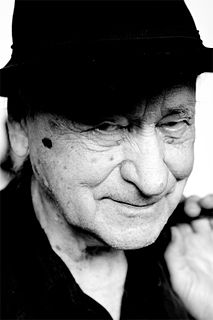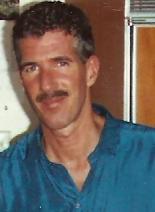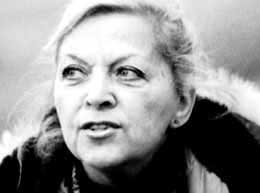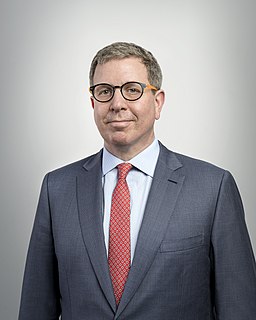Related Research Articles

Agnes Bernice Martin, RCA, was a Canadian-born American abstract painter. Her work has been defined as an "essay in discretion on inward-ness and silence". Although she is often considered or referred to as a minimalist, Martin considered herself an abstract expressionist. She was awarded a National Medal of Arts from the National Endowment for the Arts in 1998. She was elected to the Royal Canadian Academy of Arts in 2004.

Jonas Mekas was a Lithuanian-American filmmaker, poet, and artist who has been called "the godfather of American avant-garde cinema" on many occasions. His work has been exhibited in museums and at festivals worldwide.

Adolfas Mekas was a Lithuanian-born American filmmaker, writer, director, editor, actor and educator. With his brother Jonas Mekas, he founded the magazine Film Culture, as well as the Film-Makers' Cooperative and was associated with George Maciunas and the Fluxus art movement at its beginning. He made several short films, culminating in the feature Hallelujah the Hills in 1963, which was played at the Cannes Film Festival of that year and is now considered a classic of American film.

Empire is a 1964 black-and-white silent art film by Andy Warhol. When projected according to Warhol's specifications, it consists of eight hours and five minutes of slow motion footage of an unchanging view of the Empire State Building. The film does not have conventional narrative or characters, and largely reduces the experience of cinema to the passing of time. Warhol stated that the purpose of the film was "to see time go by." One week after the film was shot, experimental filmmaker Jonas Mekas speculated in the Village Voice that Warhol's movie would have a profound influence on avant-garde cinema. In 2004, Empire was included in the annual selection of 25 motion pictures added to the National Film Registry of the Library of Congress deemed "culturally, historically, or aesthetically significant" and recommended for preservation.

The Mambo Kings is a 1992 French–American musical drama film based on the 1989 Pulitzer Prize-winning novel The Mambo Kings Play Songs of Love by Oscar Hijuelos. Directed and produced by Arne Glimcher, the film stars Armand Assante, Antonio Banderas, Cathy Moriarty and Maruschka Detmers. Set in the early 1950s, the story follows Cesar (Assante) and Nestor Castillo (Banderas), brothers and aspiring musicians who flee from Havana, Cuba to New York City to escape danger. The film marks Glimcher's directing debut, and features Banderas in his first English-language role.

Cynthia Morris Sherman is a Pictures Generation American artist whose work consists primarily of photographic self-portraits, depicting herself in many different contexts and as various imagined characters.

Shirley Clarke was an American experimental and independent filmmaker, director and editor.
Sleep is a 1964 American avant-garde film by Andy Warhol. Lasting five hours and 20 minutes, it consists of looped footage of John Giorno, Warhol's lover at the time, sleeping.

Warren Sonbert was an American experimental filmmaker whose work of nearly three decades began in New York in the mid-1960s, and continued in San Francisco throughout the second half of his life. Known for the exuberant imagery of films such as Carriage Trade and especially for their intricate and innovative editing, he has been described as "the supreme Romantic diarist of the cinema" as well as "both a probing and playful artist and a keen intellect reveling in the interplay between all the creative arts."

Storm de Hirsch (1912–2000) was an American poet and filmmaker. She was a key figure in the New York avant-garde film scene of the 1960s, and one of the founding members of the Film-Makers' Cooperative. Although often overlooked by historians, in recent years she has been recognized as a pioneer of underground cinema.
Arnold "Arne" Glimcher is an American art dealer, film producer and director. He is the founder of The Pace Gallery. Glimcher has also produced and directed several films, including The Mambo Kings and Just Cause. He is the father of art dealer Marc Glimcher.
The Pace Gallery is an American contemporary and modern art gallery with 10 locations worldwide. It was founded in Boston by Arne Glimcher in 1960. His son, Marc Glimcher, is now president and CEO. Pace Gallery operates three spaces in New York City, and others in California, in China, in London and in Paris.

Kerry Tribe is an American visual artist who works primarily in film, video, and installation.
Stuart Comer is an American art curator and writer who is currently Chief Curator of Media and Performance Art at The Museum of Modern Art in New York City. He was co-curator of the 2014 Biennial at the Whitney Museum of American Art, alongside Michelle Grabner and Anthony Elms.

Frances Morris is the director of Tate Modern art gallery in London. She succeeded Chris Dercon in January 2016.
Agnes Martin: Between the Lines is a 2016 documentary film about the abstract painter Agnes Martin. It is based on footage which director Leon d'Avigdor took when they met in 2002 in Taos, New Mexico, Martin's final place of residence. The first version was a 15-minute film which was shown for three months several times daily during the stop of the large 2015/2017 retrospective of the artist, organized by Tate Modern, at Kunstsammlung NRW in Duesseldorf, Germany. It was also screened on various other occasions, mostly for educational purposes. The feature-length documentary was published on DVD in February 2016 for the European and in April 2016 for the North-American market. The film played in the official selection of 2016 Santa Barbara Fine Arts Film Festival.

Marc Glimcher is an American art dealer who is the President and CEO of Pace Gallery, a modern and contemporary art gallery founded by his father, Arne Glimcher, in Boston in 1960. He and his father were cited among the top 100 most powerful people in the international art world, according to the annual "Power 100" list published by ArtReview. In 2012, Glimcher sold a Gerhard Richter painting for more than $20 million at Art Basel in Basel, Switzerland.
Charlotte Prodger is a British artist and film-maker who works with "moving image, printed image, sculpture and writing". Her films include Stoneymollan Trail (2015) and Bridgit (2016). In 2018 she won the Turner Prize.
Walden, originally titled Diaries, Notes and Sketches , is a 1968 American film by experimental filmmaker Jonas Mekas. After several years of filming everyday scenes from his life, Mekas was commissioned by the Albright–Knox Art Gallery to make Walden. It was his first major diary film, and he named it after Henry David Thoreau's 1854 memoir Walden. Mekas's film has received acclaim as a work of avant-garde cinema.
Gallery House, London was a nonprofit art space founded in 1972 by Sigi Krauss, which was open for sixteen months until its abrupt closure in 1973. Gallery House hosted exhibitions, residencies, performances, "happenings", and events.
References
- 1 2 "Agnes Martin, 'Gabriel', 1976, Museum of Modern Art Collection". Museum of Modern Art. Retrieved 22 January 2016.
- ↑ Princenthal, Nancy (2015). Agnes Martin: Her Life and Art. London: Thames & Hudson. p. 199. ISBN 978-0-500-09390-0.
- ↑ Princenthal, Nancy (2015). Agnes Martin: Her Life and Art. London: Thames & Hudson. p. 200. ISBN 978-0-500-09390-0.
- 1 2 Lance, Mary (2002). Agnes Martin: With my Back to the World. Corrales: New Deal Films.
- 1 2 Campbell, Suzan (15 May 1989). "Oral history interview with Agnes Martin". Archives of American Art Journal: 30.
- ↑ Simon, Joan (May 1996). "Perfection is in the Mind: An Interview with Agnes Martin" (PDF). Art in America. 84 (5): 124.
- ↑ "Meeting Gabriel | Affidavit". Affidavit. Retrieved 2018-10-12.
- ↑ Gruen, John (September 1976). "Agnes Martin: 'Everything, everything is about feeling...feeling and recognition'". ARTnews: 94.
- ↑ Glimcher, Arne (2012). Agnes Martin: Paintings, Writings, Remembrances. London and New York: Phaidon.
- ↑ Brandauer, Aline Chipman; Hammond, Harmony; Wilson, Ann (1998). Agnes Martin: Works on Paper. Santa Fe: Museum of Fine Arts, Museum of New Mexico. p. 5.
- 1 2 3 Krauss, Rosalind; Haskell, Barbara (1993). Agnes Martin. New York: Whitney Museum of American Art. p. 156.
- ↑ Mekas, Jonas (12 May 1977). "Advertisement for screening". SoHo Weekly News .
- 1 2 "Agnes Martin paintings at Kettle's Yard". University of Cambridge. 2010-05-12. Retrieved 2016-01-29.
- ↑ "Dia Art Foundation: October Dia News". myemail.constantcontact.com. Retrieved 2016-01-29.
- ↑ "Agnes Martin's Gabriel | DIM Cinema". www.dimcinema.ca. Retrieved 2016-01-29.
- ↑ "Rep Diary: Gabriel & Creation - Film Comment". Film Comment. Retrieved 2016-01-29.
- ↑ "Agnes Martin: Gabriel | Tate". www.tate.org.uk. Retrieved 2016-01-29.
- ↑ "experimental film club". experimentalfilmclub.blogspot.ie. Retrieved 2016-01-29.
- ↑ "Clips: An Evening with Agnes Martin". Eventbrite. Retrieved 2016-01-29.
- ↑ "Agnes Martin:Gabriel - WeAreOCA". WeAreOCA. Retrieved 2016-02-09.
- ↑ "Gabriel by Agnes Martin". Guggenheim. 2016-10-03. Retrieved 2017-01-08.
- ↑ "Agnes Martin Double Bill". Art Cinema OFFoff (in Dutch). Retrieved 2019-10-07.
- ↑ "STAFF PICK: Gabriel". Roxie Theater. Retrieved 2020-02-09.
- ↑ Mekas, Jonas (2 June 1977). "Movie Journal". SoHo Weekly News .
- ↑ Glimcher, Arne; Morris, Frances. "Agnes Martin: Arne Glimcher in conversation with Frances Morris, April 2013". Tate. Retrieved 22 January 2016.